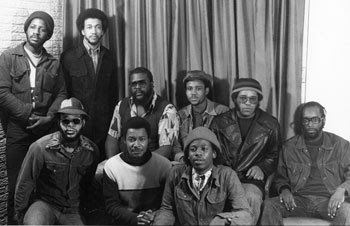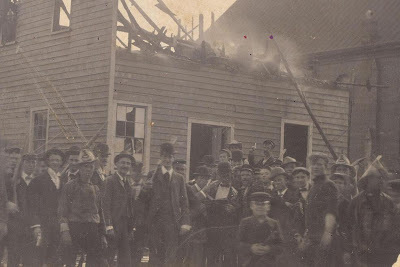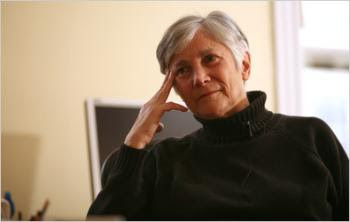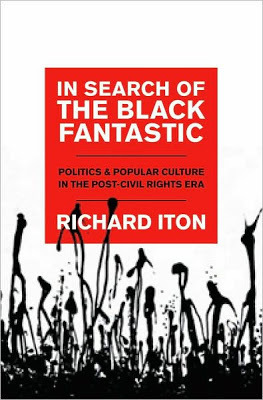Mark Anthony Neal's Blog, page 929
January 9, 2013
The Wilmington 10: A Struggle in History

The Wilmington 10: A Struggle in History by Lamont Lilly | special to NewBlackMan(in Exile)
On Dec. 31, outgoing North Carolina governor, Beverly Perdue, pardoned The Wilmington 10 -- Rev. Benjamin Chavis, Connie Tindall, Marvin Patrick, Wayne Moore, Reginald Epps, Jerry Jacobs, James McKoy, Willie Earl Vereen, William Wright, Jr. and Ann Shepard -- who had sentences ranging from 15 to 34 years following their convictions in 1972. Thankfully, a prolonged national struggle emerged and Perdue was forced to publicly admit that their sentences were “tainted by naked racism” (CNN, Jan. 1). On the very last day of 2012, justice was finally served for the nine Black and one white member of the 10.
In 1978, N.C. governor, Jim Hunt, had reduced the sentences of the 10 but offered no pardon. In 1980, formal charges against The Wilmington 10 were overturned but still on record. It was later reported that prosecutors had manufactured evidence and coerced witnesses. Three of the state’s key witnesses recanted their testimonies in 1980, admitting they had committed perjury. Most of the members of the 10 spent several years in jail. Before Perdue’s pardon, the NC chapter of the NAACP revealed newly discovered documentation that prosecutors intentionally sabotaged the first trial to manipulate jury selection.
Background on the case
In 1971, racial outbursts in the city of Wilmington shocked the world. The political and social undercurrent of racism and bigotry were still festering in the aftermath of the signing of historic Civil Rights bills in 1964 and 1965. Police had murdered a black teenager, while two white security guards had been killed.
The National Guard was called to patrol the city, to protect its downtown and commercial district from a potential race war. All of the key players were in attendance – the Klu Klux Klan and their local support organization, The Rights of White People – while frustrated Black residents including youth towed the progressive side. Anyone who pressed for change and racial solidarity became a threat to social order and the complete reign of white supremacy. Though skin color was the major line, Blacks weren’t the only targets. White allies who were seen as ‘trying to make integration work’ were also targeted by the Klu Klux Klan. White southerner and superintendent of schools, Hayward Bellamy was almost lynched to death in front of his family.
In the newly integrated schools, tensions from the classroom spilled over into the hallways, cafeteria and common areas. Public education was in serious disarray. Black and white residents avoided the streets, while local congregations were in the heat of battle. Wilmington had recently failed at forced integration when Black students were discriminated against in the classroom, from participating in student government, and barred from the debate team and glee club. The city’s false brand of integration had blocked its newly arriving Black students from a 1898—a reign of racist terror
The experiences of The Wilmington 10 actually date back to the 1898 Wilmington Race Riots, to a time of overt racial oppression and forced inequality. These race riots marked a new era of racist reign just two years after the U.S. Supreme Court upheld Jim Crow segregation through Plessy vs Ferguson. This gave the green light to many Black and progressive whites being forcibly evicted from their homes by white supremacists and southern elitists.
 The first order of business for local Klansmen was to break the backs of Wilmington’s black working-class, to disenfranchise their economic stronghold, which by 1895 had just begun to thrive. At this time, Wilmington was the national symbol of Black hope. It was in Wilmington where Blacks owned land and openly participated in local politics. In this small budding city on the outer banks of North Carolina, Blacks were crafts workers, tailors and furniture makers. They were brick-masons, teachers and architects. They were plumbers, plasterers and even owned a newspaper, The Daily Record. Blacks in Wilmington owned 20 of the city’s 22 barbershops and one of the city’s three real estate firms. As then the largest and most prominent city in N.C., it also had a Black-majority population. At the close of the 19th century, Wilmington was one of the few cities in the U.S. were both Black and white people employed each other.
The first order of business for local Klansmen was to break the backs of Wilmington’s black working-class, to disenfranchise their economic stronghold, which by 1895 had just begun to thrive. At this time, Wilmington was the national symbol of Black hope. It was in Wilmington where Blacks owned land and openly participated in local politics. In this small budding city on the outer banks of North Carolina, Blacks were crafts workers, tailors and furniture makers. They were brick-masons, teachers and architects. They were plumbers, plasterers and even owned a newspaper, The Daily Record. Blacks in Wilmington owned 20 of the city’s 22 barbershops and one of the city’s three real estate firms. As then the largest and most prominent city in N.C., it also had a Black-majority population. At the close of the 19th century, Wilmington was one of the few cities in the U.S. were both Black and white people employed each other. The second order of business was the white working class who had allied with local Blacks. The Klu Klux Klan was looking to intimidate anyone who supported an interracial new America. In 1898, armed white militia terrorized such social unity and achievements. Hate mongers burned down businesses and the headquarters of the Black-owned newspaper. Well-organized mobs targeted successful Black citizens and local leaders with direct violence, gunfire and permanent banishment. The offices of Black politicians and city officials were raided and taken over. Wilmington’s 1898 Race Riot was a critical turning point in the history of the South, a crucial blow to the pursuit of freedom and equality for all.
Needless to say, The Wilmington 10 and the racial outburst of 1971 was merely a reflection of deep-rooted oppression from decades earlier – political and social conditions that restricted progress in Wilmington, forcing Black youth to take a stand in response to being fed up with the city’s 70-year status quo.
The Wilmington 10 are a testament to the spirit of true resistance, the epitome of people power, and the potential of interracial solidarity. As high school youth, The Wilmington 10 lived what we must embody today – the will of struggle in the face of hate. Their recent pardon was a big step forward in the struggle for justice, but the people must never forget. As the next wave of revolutionaries, we must borrow from their spirit. We must take their batons and continue to march on.
***
Lamont Lilly is a contributing editor with the Triangle Free Press, Human Rights Delegate with Witness for Peace and organizer with Workers World Socialist Party. He resides in Durham, NC. Follow him on Twitter @LamontLilly.
Published on January 09, 2013 04:02
January 8, 2013
Palimpsest—Vol. 1, Issue 2: Transforming Black Men in Feminism; Guest Editors David Ikard & Mark Anthony Neal

<!-- /* Font Definitions */ @font-face {font-family:Cambria; panose-1:2 4 5 3 5 4 6 3 2 4; mso-font-charset:0; mso-generic-font-family:auto; mso-font-pitch:variable; mso-font-signature:3 0 0 0 1 0;} /* Style Definitions */ p.MsoNormal, li.MsoNormal, div.MsoNormal {mso-style-parent:""; margin:0in; margin-bottom:.0001pt; mso-pagination:widow-orphan; font-size:12.0pt; font-family:"Times New Roman"; mso-ascii-font-family:Cambria; mso-ascii-theme-font:minor-latin; mso-fareast-font-family:Cambria; mso-fareast-theme-font:minor-latin; mso-hansi-font-family:Cambria; mso-hansi-theme-font:minor-latin; mso-bidi-font-family:"Times New Roman"; mso-bidi-theme-font:minor-bidi;} @page Section1 {size:8.5in 11.0in; margin:1.0in 1.25in 1.0in 1.25in; mso-header-margin:.5in; mso-footer-margin:.5in; mso-paper-source:0;} div.Section1 {page:Section1;} </style> <br /><div class="MsoNormal"><br /></div><div class="MsoNormal"><br /></div><div class="MsoNormal"><br /></div><div class="MsoNormal"><br /></div><div class="MsoNormal"><span style="font-size: small;"><a href="http://www.sunypress.edu/p-5514-palim... style="font-family: Cambria;">Palimsest—Volume 1, Issue 2</span></b></a></span></div><span style="font-size: small;"> <b></b></span><span style="font-size: small;"><span class="maintext"><br /><b>Editor’s Introduction</b><br /> Black Male Feminism 101<br /> <i>T. Denean Sharpley-Whiting and Tiffany Ruby Patterson-Myers</i><br /> <br /> <b>Guest Editor’s Introduction</b><br /> Transforming Black Men In Feminism<br /> <i>David Ikard and Mark Anthony Neal</i><br /> <br /> <b>Essays</b><br /> <br /> Yearning to Be What We Might Have Been: Queering Black Male Feminism<br /> <i>Eric Darnell Pritchard</i><br /> <br /> Easier Said Than Done: Making Black Feminism Transformative for Black Men<br /> <i>David Ikard</i><br /> <br /> Bruised and Misunderstood: Translating Black Feminist Acts in the Work of Tyler Perry<br /> <i>Nicole Hodges Persley</i><br /> <br /> Feminism and the Streets: Urban Fiction and the Quest for Female Independence in the Era of Transactional Sexuality<br /> <i>Beauty Bragg and David Ikard</i><br /> <br /> Finding Tea Cake: An Imagined Black Feminist Manhood<br /> <i>Mark Anthony Neal</i><br /> <br /> <b>Reviews</b><br /> <br /> <i>Thug Life: Race, Gender, and the Meaning of Hip Hop</i> by Michael Jefferies<br /> Review by Regina Bradley<br /> <br /> “Quaring” Black Manhood in <i>Brother to Brother</i>: A Film Review Essay<br /> Review by Jenise Hudson<br /> <br /> <b>A Commentary</b><br /> <br /> Hip hop Feminism and Failure<br /> <i>Michael Jefferies</i><br /> <br /> <b>Poetic License</b><br /> <br /> After All That Happened<br /> Conjuring Hyssop and Moving Once More<br /> <i>Houston A. Baker</i><br /> <br /> Contributors</span></span>
Published on January 08, 2013 16:09
Palimsest—Vol. 1, Issue 2: Transforming Black Men in Feminism; Guest Editors David Ikard & Mark Anthony Neal

Palimsest—Volume 1, Issue 2
Editor’s Introduction
Black Male Feminism 101
T. Denean Sharpley-Whiting and Tiffany Ruby Patterson-Myers
Guest Editor’s Introduction
Transforming Black Men In Feminism
David Ikard and Mark Anthony Neal
Essays
Yearning to Be What We Might Have Been: Queering Black Male Feminism
Eric Darnell Pritchard
Easier Said Than Done: Making Black Feminism Transformative for Black Men
David Ikard
Bruised and Misunderstood: Translating Black Feminist Acts in the Work of Tyler Perry
Nicole Hodges Persley
Feminism and the Streets: Urban Fiction and the Quest for Female Independence in the Era of Transactional Sexuality
Beauty Bragg and David Ikard
Finding Tea Cake: An Imagined Black Feminist Manhood
Mark Anthony Neal
Reviews
Thug Life: Race, Gender, and the Meaning of Hip Hop by Michael Jefferies
Review by Regina Bradley
“Quaring” Black Manhood in Brother to Brother: A Film Review Essay
Review by Jenise Hudson
A Commentary
Hip hop Feminism and Failure
Michael Jefferies
Poetic License
After All That Happened
Conjuring Hyssop and Moving Once More
Houston A. Baker
Contributors
Published on January 08, 2013 16:09
January 7, 2013
No Child Left Behind: Is Education Reform Our Vietnam?

No Child Left Behind: Is Education Reform Our Vietnam? by Mark Naison | Special to NewBlackMan (in Exile)
In the spring and summer of 1965, as US policy makers debated whether to send large numbers of US ground troops to Vietnam to insure that the South Vietnamese government not collapse , a longtime Washington insider named George Ball issued a fierce warning that the policy being recommended would be disastrous.
Declaring that the conflict in Vietnam was a “civil war among Asians” not a front of a global struggle against Communism, Ball warned that sending US ground troops lead would lead to national humiliation no matter how large the force sent or the technological advantage it possessed because it would cement the character of the war, from the Vietnamese side, as a struggle against a foreign invader. Ball’s advice needless to say, was disregarded, and the result was exactly as he predicted- a humiliating defeat for the US which extracted a terrifying toll in deaths and ecological damage on the Vietnamese people.
In our time, a bi-partisan initiative of equal import, though less immediately destructive consequences, a movement to revitalize public education in the US and eliminate racial and economic gaps in educational performance, has prompted an equally momentous dissent from a Washington insider, this time in the person of a education scholar Dr. Diane Ravitch.
An Undersecretary of Education in the Bush Administration, and an initial supporter of landmark “No Child Left Behind” legislation, Ravitch became convinced that the fundamental assumption that undergirded the bi-partisan Education Reform, that the “achievement gap” between Black and Latino and White and Asian students was caused by “bad teachers” and recalcitrant teachers unions rather than entrenched poverty, would lead to policy recommendations that would demoralize teachers, destabilize the nation’s public school system, profession, encourage privatization and profiteering and, in the long run, increase performance gaps between racial and economic groups.
As with George Ball before her, Dr. Ravitch’s recommendations were systematically ignored not only by the administration that appointed her, but the administration which replaced it. And as with George Ball, her warnings are proving to be eerily prophetic. All over the nation, policies are being implemented which are leading to demoralization of teachers, to closing of schools which honorably served communities for generations, to marginalization of special needs and ELL students, to testing scandals in high needs schools and districts, and to an uncontrolled proliferation of tests that has put profits in the pockets of test companies, while pushing aside science, history and the arts, and making a growing number of students hate going to school.
The question is not whether these policies- an odd mixture of privatization, universal testing, and teacher/ school accountability based on student test scores- will be effective in reducing the impact of poverty on educational performance. The question is how much damage will be done before a critical portion of the public, the media, and the nation’s political leadership realizes how counterproductive these policies are.
If Vietnam is any precedent, such a “national wake up call” on educational policy could be quite long in coming, and the damage inflicted immense. And as with Vietnam, only massive protest and civil disobedience will be able to stop the policy in its tracks.
***
Mark Naison is a Professor of African-American Studies and History at Fordham University and Director of Fordham’s Urban Studies Program. He is the author of two books, Communists in Harlem During the Depression and White Boy: A Memoir. Naison is also co-director of the Bronx African American History Project (BAAHP). Research from the BAAHP will be published in a forthcoming collection of oral histories Before the Fires: An Oral History of African American Life From the 1930’s to the 1960’s.
Published on January 07, 2013 19:55
Obama's Cheney? "Assassination Czar" John Brennan Brings Legacy of Drone War and Torture to CIA Nod
DemocracyNow.org
Dubbed the assassination czar, presumptive CIA nominee John Brennan has played a key role backing some of the nation's most controversial post-9/11 policies from the secret drone war to wireless surveillance. Brennan was a rumored pick for the job when Obama was first elected in 2008, but was forced to withdraw from consideration amid protests over his role at the CIA under George W. Bush and his public support for the CIA's policies of so-called "enhanced interrogation techniques" and extraordinary rendition. We're joined by Marcy Wheeler, an investigative blogger with the website, EmptyWheel. Wheeler calls Brennan's nomination, "a testament to what kind of hard-nosed person Barack Obama has become and the degree to which his policies are really just a continuation of the Bush-Cheney policies."
Published on January 07, 2013 08:32
January 6, 2013
Al Jazeera English: Ohio Football Rape Scandal Unravels Online
Al Jazeera English
There's been anger and outrage in the US state of Ohio over the alleged rape of a teenage girl by two high school football players.
A candelight vigil has been held in the town of Steubenville, where many in the town feel the athletes are being given preferential treatment.
The case has attracted more attention because of internet postings by the computer group Anonymous.
Published on January 06, 2013 16:26
Schomburg Director Khalil Gibran Muhammad on the Anniversary of the Emancipation Proclamation
Published on January 06, 2013 05:15
January 5, 2013
Independent Lens | 'Soul Food Junkies' – Premieres January 14th
Premiering January 14, 2013 (check local listings):
http://www.pbs.org/independentlens/broadcast.html
A Film by Byron Hurt
In this excerpt from the Independent Lens documentary, Soul Food Junkies, filmmaker Byron Hurt visits Jackson, Mississippi to learn more about soul food cooking and describes some of the health concerns related to traditional Southern cuisine.
About the Film
Baffled by his dad's reluctance to change his traditional soul food diet in the face of a health crisis, filmmaker Byron Hurt sets out to learn more about this rich culinary tradition and it's relevance to black cultural identity. He discovers that the love affair that his dad and his community have with soul food is deep-rooted, complex, and in some tragic cases, deadly. Through candid interviews with soul food cooks, historians and scholars, as well as doctors, family members, and everyday people, Soul Food Junkies puts this culinary tradition under the microscope to examine both its benefits and consequences. Hurt looks at the socioeconomics of predominantly black neighborhoods, where it can be difficult to find healthy options, and wonders if soul food has become an addiction in his community.
Published on January 05, 2013 19:30
Remembering Alvin Ailey on his Birthday
CBS News (2008)
The Alvin Ailey American Dance company is celebrating its 50th anniversary. Although the acclaimed troupe has evolved, it still operates on the same premise: accessibility. Michelle Miller reports.
Published on January 05, 2013 19:02
Graduate Seminar: Critical Readings in Black Popular Culture

Graduate Seminar: Critical Readings in Black Popular Culture – AAAS 890S-01
Duke University Professor Mark Anthony Neal, Ph.D. Monday 6:15 – 8:45
Course Synopsis
Critical Readings in Black Popular Culture examines historic examples of black popular expression and the ways that this expression has been used to articulate African-American and other diasporic identities within the political, social and cultural realms. In addition the course will take into account the ways in which a developing “culture industry” undermined, distorted and affirmed essentialist notions of “Black” identity and the ways that black cultural workers have used popular culture to counter this process, while also taking advantage of the economic and social opportunities provided by the ”culture industry . Topics will include popular aesthetic movements such as the Black Arts and Post-Soul Movements, the emergence of and institutionalization of hip-hop, Blaxploitation era cinema, black television, black visual art, black performance studies, the generational divide(s) within black popular culture and the discourses of race, gender, sexuality, ethnicity and class which circulate through black popular culture.
Texts
Stuart Hall: Critical Studies in Cultural Studies —ed. David Morley and Kuan-Hsing Chen
Bodies in Dissent: Spectacular Performances of Race and Freedom, 1850-1910 —Daphne Brooks
Beyond Blackface: African Americans and the Creation of American Popular Culture, 1890-1930—ed. W. Fitzhugh Brundage
Prove It On Me: New Negroes, Sex, and Popular Culture in the 1920s —Erin D. Chapman
Laughing Fit to Kill: Black Humor in the Fictions of Slavery —Glenda Carpio
In Search of the Black Fantastic: Politics and Popular Culture in the Post Civil Rights Era —Richard Iton
Sounding Like a No-No: Queer Sounds and Eccentric Acts in the Post-Soul Era —Francesca T. Royster
Stare in the Darkness: The Limits of Hip-Hop and Black Politics —Lester Spence
Go-Go Live: The Musical Life and Death of a Chocolate City —Natalie Hopkinson
Troubling Vision: Performance, Visuality, and Blackness —Nicole R. Fleetwood
Soul Power: Culture, Radicalism and the Making of a U.S. Third World Left —Cynthia A. Young
Migrating to the Movies: Cinema and Black Urban Modernity —Jacqueline Stewart
Revolution Televised: Prime Time and the Struggle for Black Power —Christine Acham
Published on January 05, 2013 09:13
Mark Anthony Neal's Blog
- Mark Anthony Neal's profile
- 30 followers
Mark Anthony Neal isn't a Goodreads Author
(yet),
but they
do have a blog,
so here are some recent posts imported from
their feed.



